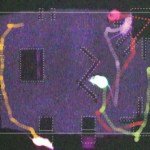Elad Schneidmann
What effect does a constant stream of engaging stimuli have on our relationships? On our social structure as a whole? What percentage of our actions is influenced by others, and how does this translate, at some point, into group behavior?
Neurobiologists Prof. Alon Chen and Dr. Elad Schneidman of the Weizmann Institute and their team members have been using mice to investigate these questions. Chen and Schneidman approach the group as a network composed of the joint behavior patterns of mice that had had their fur dyed in bright, glow-in-the-dark colors. Among other things, this enables the…
What does a tiny patch of salamander retina see when it watches a movie? Weizmann Institute scientists, together with Dr. Ronen Segev at Ben-Gurion University, performed this experiment - literally showing film sequences to snippets of live retina tissue and recording the interactions between their 100 or so active neurons.
Seeing, as we know, is 3/4 interpretation and, contrary to common belief, this interpretation begins in the eye, before an image ever reaches the brain. Dr. Elad Schneidman and his colleagues found that unique patterns of neuron activity could be identified: There were…
Even severely paralyzed people on respirators can do it: They can sniff. That is, they can at least partially control the movement of air through their nostrils. And if they can sniff, they can use this action to write on a computer screen or steer a wheelchair. That's the principle behind a new device developed by Prof. Noam Sobel, students and electronics engineers in the Weizmann Institute's Neurobiology Department.
After teaching healthy volunteers to play computer games using a "sniff control" in lieu of a mouse or joystick, the Weizmann team entered into collaboration with Dr Nachum…

